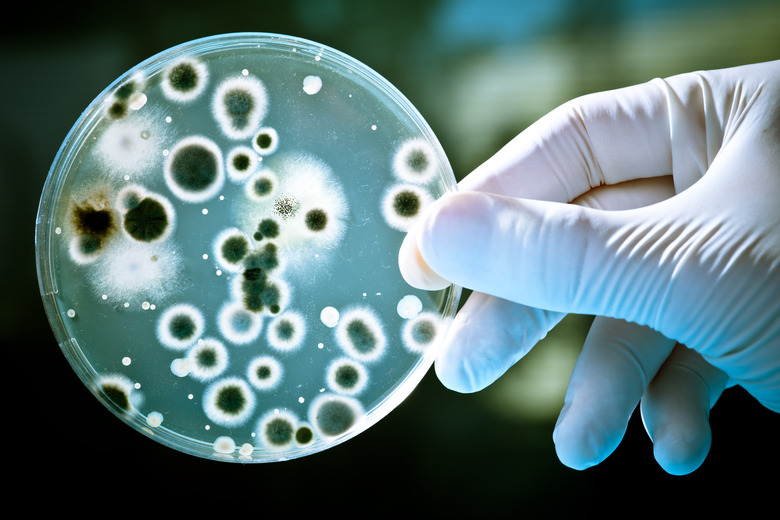How Do I Isolate Bacteria From Soil?
Isolating bacteria from soil is an important first step in many microbiology experiments. Once they are isolated, bacteria can be further analyzed to determine things, such as their species and their function in the soil environment. Even a tiny amount of soil can contain millions of bacteria, which makes it necessary to dilute a soil sample before isolating bacteria from the sample.
Step 1
Measure 100 ml. distilled water in the graduated cylinder and add it to the sterile bottle.
Step 2
Weigh out 1 g of the soil sample and add it to the bottle of distilled water. Tightly cap the bottle and shake it to thoroughly mix the solution.
Step 3
Label the sterile test tubes "10^-3," "10^-4," "10^-5," and "10^-6." Add 9 ml of distilled water to each of the tubes, using one of the pipettes.
Step 4
Transfer 1 ml of the solution in the bottle to the tube labeled "10^-3," using a new pipette. Cap the tube and swirl it gently until the solution is well mixed.
Step 5
Transfer 1 ml of the solution in the "10^-3" test tube to the "10^-4" tube with a new pipette. Cap the "10^-4" tube and swirl to mix. Repeat this method to transfer solution from the "10^-4" tube to the "10^-5" tube and then from the "10^-5" tube to the "10^-6" tube.
Step 6
Plate three samples each from the "10^-4," "10^-5" and "10^-6" tubes. Use a new pipette to transfer 1 ml of solution from the tube into a Petri plate. Add about 15 ml of nutrient agar to the plate; then put the lid on the plate and swirl gently so that the agar covers the bottom of the plate.
Step 7
Make a control plate by putting 1 ml of distilled water into a Petri plate, using a new pipette. Add agar; put the lid on and swirl the plate.
Step 8
Leave the Petri plates upright until the agar has set. Then invert the plates and incubate them—either in an incubator or at room temperature—for as little as 24 hours and up to five days.
Step 9
Remove the plates from the incubator after the desired amount of incubation time. Count the bacterial colonies on plates containing about 30 to 300 colonies. Use a permanent marker to mark the colonies you have already counted in order to avoid counting the same colonies twice.
Step 10
Divide the number of colonies counted by the dilution—"10^-4," "10^-5" or "10^-6"—of the soil solution for each plate. Find the number of cultivatable bacteria in the original gram of soil by averaging the results from each countable plate.
Things Needed
- Distilled water
- Graduated cylinder
- Sterile bottle with lid
- Soil sample
- 4 sterile capped test tubes
- 15 sterile 1 ml. pipettes
- Prepared nutrient agar at about 45 degrees C
- 10 sterile Petri plates
- Permanent marker
TL;DR (Too Long; Didn't Read)
Follow aseptic laboratory techniques throughout the procedure.
Warning
To prevent contamination and possible infection from the bacteria, make sure to properly dispose of all Petri plates, soil solutions and pipettes.
This procedure only measures cultivatable bacteria. According to Cornell University, between 90 and 99 percent of soil bacteria will not grow on nutrient agar.
References
- Florida International University: Isolation of Soil Bacteria: Viable Isolation and Pure Culture
- Cornell University: Enrichment and Isolation Lab
- "Lab Manual for Soil Microbiology"; David Zuberer, Ph.D.
Cite This Article
MLA
Wakefield, Petra. "How Do I Isolate Bacteria From Soil?" sciencing.com, https://www.sciencing.com/do-isolate-bacteria-soil-6918955/. 9 March 2018.
APA
Wakefield, Petra. (2018, March 9). How Do I Isolate Bacteria From Soil?. sciencing.com. Retrieved from https://www.sciencing.com/do-isolate-bacteria-soil-6918955/
Chicago
Wakefield, Petra. How Do I Isolate Bacteria From Soil? last modified March 24, 2022. https://www.sciencing.com/do-isolate-bacteria-soil-6918955/
